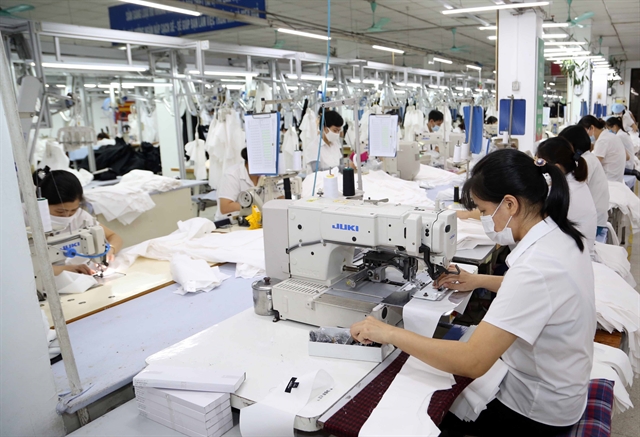 Economy
Economy

Việt Nam-UK trade saw positive developments with two-way trade turnover reaching US$6.02 billion over the first 11 months of 2021, up 17 per cent year-on-year

|
| A factory of Garment 10 Corp, which is exporting garments to the UK market. — VNA/VNS Photo Trần Việt |
HÀ NỘI — Amid the COVID-19 pandemic, resulting in the disruption of the global supply chain, Việt Nam-UK trade saw positive developments with two-way trade turnover reaching US$6.02 billion in the first 11 months of 2021, up 17 per cent year-on-year, according to the European-American Market Department of the Ministry of Industry and Trade.
Exports from Việt Nam to the UK hit US$5.2 billion, up 15.6 per cent year-on-year. Export items that recorded high growth included iron and steel, rubber, agricultural produce, vehicles and spare parts, and machinery.
Việt Nam imported about US$778.2 million worth of goods from the UK, a yearly rise of 27.3 per cent.
Despite the positive performance, the Southeast Asian nation's market share in the market remains modest, accounting for about 1 per cent of the total import turnover of the European nation.
Vietnamese Trade Counselor in the UK Nguyễn Cảnh Cường said that after Brexit, the UK-Việt Nam Free Trade Agreement (FTA) had replaced the EU-Việt Nam FTA from January 1, 2021.
Meanwhile, the UK Government is carrying out a more open trade policy toward faster liberalisation, encouraging British businesses to boost exports in countries with dynamic economic development, including Việt Nam. This is viewed as an opportunity for the two sides to promote trade and business cooperation in the future, according to Cường, who attended a webinar last week.
However, the UK market also poses many challenges for Vietnamese businesses, especially after the country left the EU.
Cường outlined procedures regarding certificates and customs controls over animals and plants, tax declaration and tax payments, which were subject to new British guidelines, as well as changes in consumer shopping habits during the pandemic.
Dario Miraglia, trading manager at Vestey Foods International, which specialises in importing and distributing vegetables, said that enterprises exporting to the UK should carefully study market demand and seek business partners through different channels.
In addition to general international standards and requirements, each market has its own regulations and procedures, so Vietnamese businesses needed to well-understand such regulations, Miraglia said.
Meanwhile, Ngô Thị Thu Thuỷ, head of sales and global trade at HSBC Vietnam, recommended that before signing a contract, Vietnamese enterprises should look for more information about the business situation of partners and their payment capabilities.
Hoàng Hương Giang, CEO of Garment 10 Corp, which has more than 10 years of experience in supplying products to the UK, outlined product quality and customer service as top priorities for Vietnamese firms if they wanted to penetrate international markets, including the UK.
Not only firms in the garment and textile industry, but those in other industries needed to know how to seize opportunities and prepare carefully before shaking hands with foreign partners, she said.
The UK is a major import market, with a total import turnover of more than GBP448 billion in the first nine months of 2021. The UK's top imports are cars, medical products, medicines, clothing, audio and telecommunications equipment, office machinery, electromechanical generators, non-ferrous metals, crude oil and vegetables.
Currently, the UK is one of Việt Nam's leading trading partners in Europe, while the Southeast Asian nation is the UK's top trading partner in ASEAN, ranking 26th among the European nation's export partners globally.
As of November 2021, the UK had 447 projects in Việt Nam with a total registered investment capital of nearly US$4 billion, accounting for 1.3 per cent of the total number of foreign-invested projects in the country and 1 per cent of the national total FDI.— VNS




